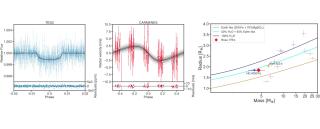It may interest you
-
 We present, for the first time, model spectra of single-age, single-metallicity stellar populations computed with the E-MILES evolutionary synthesis code incorporating an environment-dependent, variable galaxy-wide initial mass function (gwIMF). This gwIMF, calculated using the GalIMF code, is rooted in the integrated galactic initial mass function (IGIMF) theory, which predicts IMF variations as a function of the star formation rate and the metallicity. By coupling these two codes, we generated a comprehensive library of single-burst stellar population spectra uniquely sensitive to gwIMFAdvertised on
We present, for the first time, model spectra of single-age, single-metallicity stellar populations computed with the E-MILES evolutionary synthesis code incorporating an environment-dependent, variable galaxy-wide initial mass function (gwIMF). This gwIMF, calculated using the GalIMF code, is rooted in the integrated galactic initial mass function (IGIMF) theory, which predicts IMF variations as a function of the star formation rate and the metallicity. By coupling these two codes, we generated a comprehensive library of single-burst stellar population spectra uniquely sensitive to gwIMFAdvertised on -
 The TESS (Transiting Exoplanet Survey Satellite) mission has discovered many exoplanet candidates that need to be confirmed and characterized from the ground. One of them orbits Ross 176, a K-type dwarf star, where we have identified a promising hot “water-world” candidate. Using spectroscopic observations with the CARMENES instrument, we confirmed the planetary nature of the signal detected by TESS and estimated the planet’s mass. To improve the analysis, we applied an advanced statistical method called Gaussian Process, which allowed us to separate the star’s own variability (quite strongAdvertised on
The TESS (Transiting Exoplanet Survey Satellite) mission has discovered many exoplanet candidates that need to be confirmed and characterized from the ground. One of them orbits Ross 176, a K-type dwarf star, where we have identified a promising hot “water-world” candidate. Using spectroscopic observations with the CARMENES instrument, we confirmed the planetary nature of the signal detected by TESS and estimated the planet’s mass. To improve the analysis, we applied an advanced statistical method called Gaussian Process, which allowed us to separate the star’s own variability (quite strongAdvertised on -
 Measuring galaxy sizes is essential for understanding how they were formed and evolved across time. However, traditional methods based on l ight concentration or isophotal densities often lack a clear physical meaning. A recent study from Trujillo+20 explores a more physically motivated definition: the radius R 1, where the stellar surface density falls to 1 solar masses per parsec square —roughly the threshold for gas to form stars in galaxies like the Milky Way. In this work, Arjona-Gálvez+25 uses over 1,000 galaxies from several state-of-the-art cosmological simulations (AURIGA, HESTIAAdvertised on
Measuring galaxy sizes is essential for understanding how they were formed and evolved across time. However, traditional methods based on l ight concentration or isophotal densities often lack a clear physical meaning. A recent study from Trujillo+20 explores a more physically motivated definition: the radius R 1, where the stellar surface density falls to 1 solar masses per parsec square —roughly the threshold for gas to form stars in galaxies like the Milky Way. In this work, Arjona-Gálvez+25 uses over 1,000 galaxies from several state-of-the-art cosmological simulations (AURIGA, HESTIAAdvertised on
